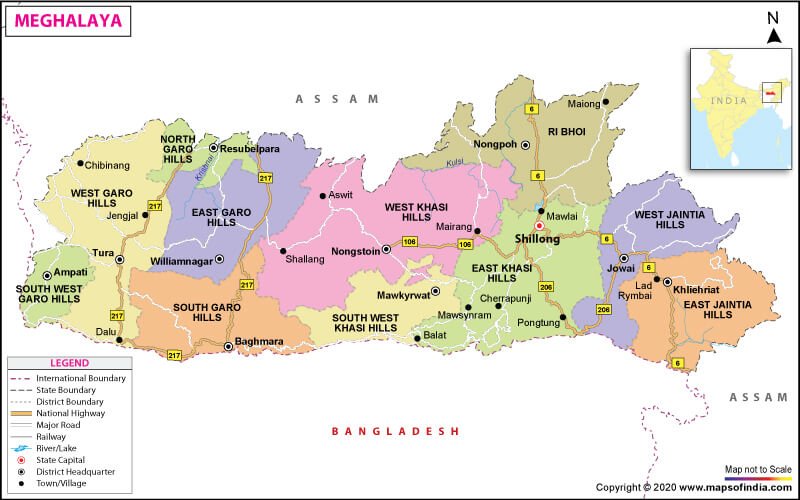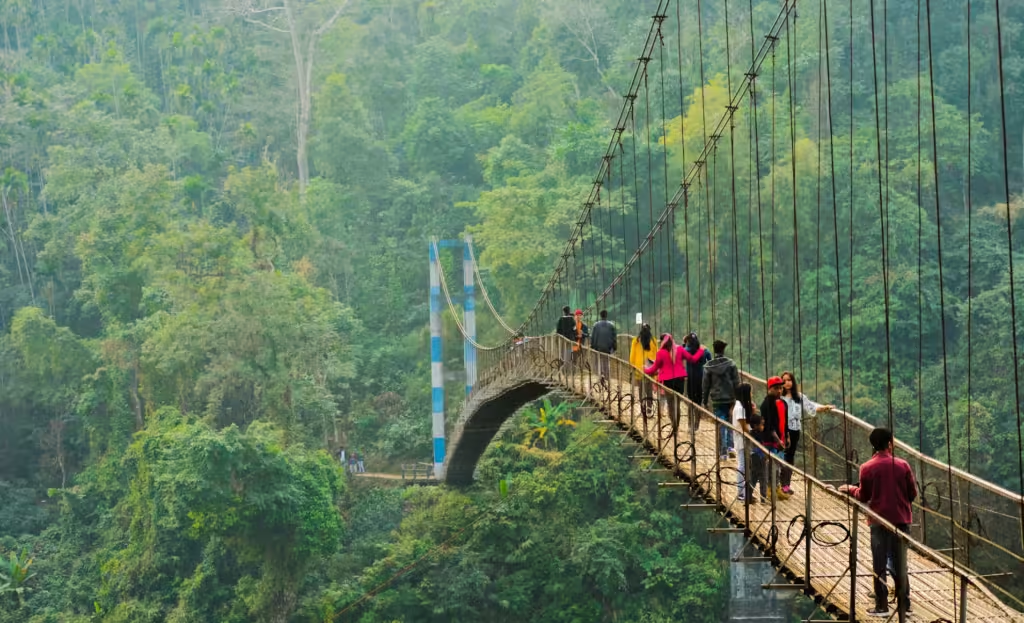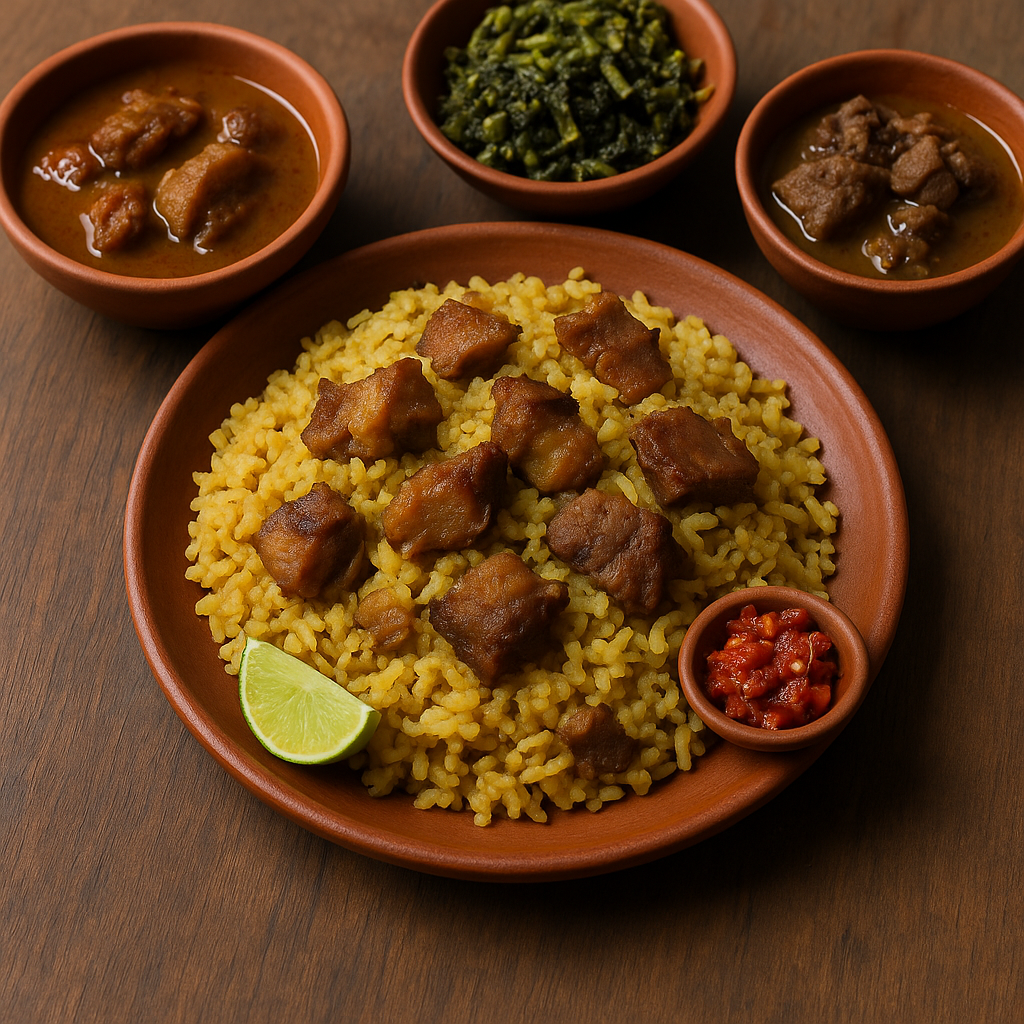A state so charming that it looks like it was taken from a fairy tale is tucked away in northeastern India. With its mist-covered hills, verdant valleys, thundering waterfalls, and ancient living root bridges that defy the laws of nature, Meghalaya, which translates to “Abode of Clouds,” lives up to its name. Meghalaya captivates you with its tranquil landscapes, adventure, and awe the moment you arrive. Every area of this state provides a captivating glimpse of India’s natural and cultural riches, whether it’s the sound of raindrops in Cherrapunji or the sight of glistening rivers coursing through Dawki. Meghalaya is more than just a place to visit; it’s a spiritual experience where tradition blends with the natural world and the skies caress the hills.

The wettest place in India is Mawsynram, a town nestled in the East Khasi Hills district of Meghalaya. It receives an eye-popping average annual rainfall of around 11,872 millimeters (467.4 inches), which is more than enough to qualify it as one of the wettest places on Earth. Mawsynram’s claim to fame is often contested by Lloró, Colombia, which reported an average yearly rainfall of 12,717 millimeters (500.7 in) between 1952 and 1989. However, Mawsynram holds the official record according to the Guinness World Records.
Physical features of Meghalaya
- Etymology and Formation:
- The name “Meghalaya” translates to “the abode of clouds” in Sanskrit.
- It was formed on January 21, 1972, by carving out two districts from the state of Assam:
- The United Khasi Hills and Jaintia Hills.
- The Garo Hills.
- Location and Boundaries:
- Meghalaya lies in the northeastern region of India and is one of the Seven Sister States.
- It is bounded by Assam to the east, north, and northwest, and by Bangladesh to the south and southwest, and the state of Tripura to the southeast.
- The state comprises mountainous plateaus, valleys, and highland areas.
- Physical Feature
- Meghalaya covers an area of approximately 22,429 square kilometers with a length-to-breadth ratio of about 3:1.
- It extends for about 300 kilometers in length and approximately 100 kilometers in breadth.
- The northeastern region of India proudly boasts Meghalaya among its states.
- Assam flanks Meghalaya to the north and east, while Bangladesh borders it to the south. The capital of Meghalaya is Shillong.
- The British, impressed by Meghalaya’s picturesque landscapes, nicknamed it the “Scotland of the East” during their rule.
- The landscape of Meghalaya mainly consists of Archean rock formations, which are geologically rich.
- These rock formations contain valuable minerals such as coal, limestone, uranium, and sillimanite.
Meghalaya’s landscape is a symphony of geological wonders and ecological beauty. The state is divided into three main hill regions: the Khasi Hills, the Garo Hills, and the Jaintia Hills—each blessed with rich biodiversity and distinct cultural footprints. Known globally for its record-breaking rainfall, towns like Cherrapunji and Mawsynram receive some of the highest amounts of rainfall on Earth, giving rise to verdant forests and an endless network of waterfalls. From the awe-inspiring Nohkalikai Falls to the intricate limestone caves of Siju and Mawsmai, Meghalaya’s geography is a playground for nature lovers and adventurers. The state’s dense forests, home to numerous endemic species, are part of the Indo-Burma biodiversity hotspot, making Meghalaya a vital ecological treasure trove that continues to attract scientists, trekkers, and conservationists alike.
Some key points about this beautiful region
- Culture and Society:
- Meghalaya’s history is steeped in a matrilineal tradition. This system traces lineage and inheritance through women.
- The youngest daughter inherits all her wealth and takes care of her parents.
- The state experiences high rainfall, with the southern Khasi Hills recording an average of 12,000 mm (470 inches) of rain annually.
- The three major cohorts are the Khasis, the Garos, and the Jaintias. In most cohorts, a matrilineal system dictates that people pass down inheritance and property through the female line.
- Meghalaya’s history is steeped in a matrilineal tradition. This system traces lineage and inheritance through women.
- Language and Official Script:
- English is the official language of Meghalaya, and the script used is the Latin script.
- Natural Vegetation:
- The state has diverse natural vegetation, ranging from tropical mixed forests in the Garo Hills to high-altitude pine forests.
- Unfortunately, unplanned cutting and grazing have adversely affected the natural vegetation.
- Common trees include pine, sal, and bamboo.
- Crops and Biodiversity:
- Major crops grown in Meghalaya include rice, potato, pineapple, maize, and banana.
- The subtropical forests are home to various bird species, mammals, and unique plants.
- This region holds an interesting theory: it might be the entry point for tigers into India.

Flora and Fauna
- Hills and Plateaus: Meghalaya is characterized by its rolling hills and plateaus, which are part of the Garo, Khasi, and Jaintia Hills ranges. These hills are covered with dense vegetation and are interspersed with valleys and rivers.
- Waterfalls: The state is home to numerous waterfalls, some of which are among the tallest in India. Nohkalikai Falls, located near Cherrapunji, is one of the most famous waterfalls in Meghalaya, plunging from a height of over 1,000 feet. Other notable waterfalls include Seven Sisters Falls, Elephant Falls, and Krang Suri Falls.
- Caves: Meghalaya boasts an extensive network of caves, many of which are still unexplored. The Khasi Hills region boasts numerous limestone caves. These caves, some containing unique geological formations and underground rivers, draw spelunkers and explorers seeking adventure. Mawsmai Cave and Siju Cave are popular tourist attractions.
- Living Root Bridges: One of the most unique features of Meghalaya’s landscape is its living root bridges. Local communities skillfully train the roots of rubber trees (Ficus elastica) over many years, eventually guiding them to form natural bridges over rivers and streams. The double-decker living root bridge near the village of Nongriat is a famous example.
- Rivers and Lakes: Numerous rivers and streams snake their way actively through Meghalaya’s hills and valleys. The crystal-clear waters of the Umngot River, near Dawki, draw in visitors for boating and water sports. Umiam Lake, also known as Barapani Lake, is a large reservoir near Shillong, offering scenic views and recreational activities.
- Sacred Groves: Local communities in Meghalaya actively preserve patches of ancient forest as sacred groves for religious and cultural reasons. Mawphlang Sacred Grove is one of the most well-known, serving as a biodiversity hotspot and a site for traditional rituals and ceremonies.
Top Tourist Attractions
Meghalaya offers an endless array of breathtaking experiences for every type of traveler. Start your journey in Shillong, the capital city often dubbed the “Scotland of the East,” known for its colonial charm, bustling markets, and music culture. Take a drive to Dawki, where the Umngot River’s glassy waters give the illusion of boats floating in air. For panoramic views, Laitlum Canyon provides a dramatic outlook over deep gorges and cloud-kissed cliffs. One cannot miss Mawlynnong, Asia’s cleanest village, where community-led cleanliness is a way of life. But the true marvel lies in Nongriat, home to the famous living root bridges—living examples of bioengineering where rubber tree roots are trained over decades to form sturdy, naturally growing pathways across streams. These are not just tourist attractions—they are symbols of human ingenuity living in sync with nature.
Local Cuisine

A journey through Meghalaya is incomplete without savoring its diverse and flavorful cuisine. The food here is rooted in tradition and sourced from nature. A must-try dish is Jadoh, a fragrant rice dish made with meat and local spices, commonly enjoyed by the Khasi community. Dohneiiong, a pork curry with black sesame seeds, showcases the region’s love for bold, earthy flavors. Bamboo shoots feature prominently in many preparations, adding a unique zest to stews and pickles. The Garos, known for their spicy cuisine, often use fresh herbs and fermented ingredients in their dishes. Don’t miss out on the region’s locally brewed rice beer, a staple during festivals and social gatherings. Meghalaya’s food is as rich in taste as its landscape, offering an authentic connection to its people and their way of life.
Festivals
Meghalaya is a land of vibrant festivals that showcase the rich culture and traditions of the people. Some of the popular festivals include:
- Nongkrem Dance Festival: A colorful festival celebrated by the Khasi community to mark the beginning of the sowing season.
- Wangala Festival: A harvest festival of the Garo community, characterized by vibrant songs, dances, and feasting.
- Shad Suk Mynsiem: A post-harvest festival celebrated by the Jaintia community, featuring traditional dances and music.
Travel Tips & Best Time to Visit
Planning a trip to Meghalaya is easier with a few practical tips. The best time to visit is from October to April, when the weather is pleasant and ideal for sightseeing. However, if you love rain-drenched landscapes, the monsoon months between June and September offer a lush, dreamlike atmosphere. The nearest major airport is in Guwahati, Assam, from where Shillong is a scenic 3-4 hour drive. Opt for homestays or eco-resorts to experience local hospitality and sustainable tourism. Local markets like Shillong’s Police Bazaar or Lewduh are perfect for picking up handicrafts and souvenirs. Make sure to travel responsibly—carry reusable bottles, respect tribal customs, and consider guided tours for a deeper understanding of the region’s ecology and culture.
Meghalaya is a paradise for nature lovers and adventure seekers. Here are some of the popular activities you can do in Meghalaya:
- Trekking: Trek through the lush green forests, explore the cascading waterfalls, and discover hidden caves.
- Caving: Meghalaya is home to some of the longest and deepest caves in India, perfect for spelunking enthusiasts.
- Boating: Enjoy a boat ride on the pristine Umngot River or visit the famous living root bridges, and natural bridges formed by the entwined roots of trees.
- Camping: Set up camp amidst the serene beauty of nature and enjoy stargazing under a clear sky.
Meghalaya is not just a place to visit—it’s a destination that inspires, humbles, and transforms. It offers a rare blend of untouched nature, deep-rooted tradition, and a warm, welcoming spirit that stays with you long after your journey ends. Whether you’re hiking through ancient forests, dancing at a tribal festival, or simply watching the clouds roll over the hills, Meghalaya invites you to reconnect with nature, with people, and with yourself. In a world chasing modernity, Meghalaya stands as a reminder of how harmony with the earth and each other can still be found. So pack your bags, open your heart, and let Meghalaya take you on a journey of wonder and discovery—because some places don’t just fill your camera roll, they fill your soul.
Unique and fascinating facts about Meghalaya
🌧️ 1. Wettest Place on Earth
Meghalaya is home to Mawsynram, the wettest place on Earth, receiving an average annual rainfall of over 11,800 mm. The region’s dense clouds, lush greenery, and frequent showers give the state its poetic name—“Abode of Clouds.”
🌉 2. Living Root Bridges
In the village of Nongriat and other parts of Meghalaya, locals have created living root bridges by training the aerial roots of rubber trees across streams and rivers. Some of these bridges are over 100 years old and strong enough to carry dozens of people at a time—a stunning example of bioengineering and harmony with nature.
🏡 3. Asia’s Cleanest Village
Mawlynnong, located in the East Khasi Hills, has earned the title of Asia’s cleanest village. The community-led cleanliness drive includes bamboo dustbins, strict waste management, and a ban on plastic, making it a model for eco-tourism and rural sustainability.
👩👧 4. Matrilineal Society
Meghalaya is one of the few places in the world where matrilineal culture is widely practiced. Among the Khasi, Garo, and Jaintia communities, lineage and inheritance pass through the mother’s line, and the youngest daughter traditionally inherits family property.
🧭 5. Caving Paradise
Meghalaya boasts over 1,500 caves, many of which are among the longest and deepest in the Indian subcontinent. Caves like Siju, Mawsmai, and Liat Prah attract adventurers and scientists alike for their stalactite formations, underground rivers, and rare species.
🥘 6. Distinctive Cuisine
The state’s food reflects tribal traditions and local ingredients. Dishes like Jadoh (rice with meat), Dohneiiong (pork with sesame), and bamboo shoot preparations are local favorites. Fermented foods and home-brewed rice beer are also part of their cultural fabric.
🎶 7. Land of Music and Talent
Shillong, the capital, is often called “India’s Rock Capital.” Music is a vital part of life in Meghalaya, with many locals excelling in Western music, especially rock and blues. The city hosts music festivals and has produced several nationally known bands and artists.
🍃 8. Biodiversity Hotspot
Part of the Indo-Burma biodiversity hotspot, Meghalaya is home to rare orchids, medicinal plants, and diverse wildlife. Its sacred groves, such as Mawphlang, are community-protected forests that are considered sacred and remain untouched by deforestation.
READ ALSO
- Agartala: A Model for Flood-Resilient Cities
- Mawsynram: Discover the Wettest Place in India and the World
- Umngot River: Meghalaya’s Crystal-Clear Gem
- India’s States and UTs: A Colorful Tapestry of Nicknames
- Mawlynnong: Asia’s Cleanest Village
- Agartala’s Flood Mitigation Project Honored at LBSNAA
- Foundation Day of States in India
- The Poisonous Red Pond of Odisha
- The Jatinga Mystery
- Sikkim Wins Best State Award for Environment Education
- Duckweed-Based Wastewater Treatment Systems
- Unique features of Indian plateaus
- India’s International Borders
- Brahmaputra: A Mighty River
- River Delta Ecosystems
- Exploring India’s Best Tourism Villages
- Sustainable living tips
- Geographical Factors Behind Darjeeling and Assam Teas
If you’re preparing for any state or national-level government exam, focusing on these topics from Meghalaya, along with current affairs, will give you a strong edge.
Your PDF file “Important Topics About Meghalaya for Government Exams” is ready for download:

Kuber Industries Wooden Oblong Manual Height Adjustable Table for Work & Study with Wheels & Storage Shelf
Multipurpose design for various tasks – Our table mate finish table can serve as a multipurpose table for home because of its design, which makes it ideal for comfortable use in your home office setup.
✅ Comfortable work-from-home solution – This laptop table for home offers a stable surface that helps you work efficiently, as it is perfect for most body types.
✅ Durable and sturdy construction – This working table for a home office is built to last because it uses high-quality materials that ensure long-term use without compromising on stability.
Frequently Asked Questions (FAQs)
A. Meghalaya is famous for its stunning natural beauty, including lush green hills, cascading waterfalls, living root bridges, and abundant wildlife. It’s also known for its unique matrilineal society and vibrant cultural traditions.
A. The best time to visit Meghalaya is during the drier months of October to April, when the weather is pleasant and rainfall is minimal. However, some travelers also enjoy visiting during the monsoon season (June to September) to witness the region’s lush greenery and spectacular waterfalls.
A. Some must-visit attractions in Meghalaya include the living root bridges of Cherrapunji and Mawlynnong, Nohkalikai Falls, Dawki with its crystal-clear Umngot River, Shillong Peak for panoramic views, and the sacred forests of Mawphlang. Adventure enthusiasts can also explore the caves and trekking trails in the region. Mawsynram (another contender for the wettest place).
A. The Khasi, Garo, and Jaintia cohorts are the dominant communities, each with distinct customs, traditions, and languages.
A. Khasi, Garo, and English are the primary languages spoken in Meghalaya. Khasi and Garo are indigenous languages.
A. Meghalaya is home to living root bridges, which are natural bridges formed by training the roots of rubber trees across streams. These bridges can support the weight of people and are a fascinating example of bioengineering.
A. Meghalaya’s economy relies on agriculture. Some important crops include rice, maize, potatoes, ginger, and turmeric.






Your article helped me a lot, is there any more related content? Thanks!